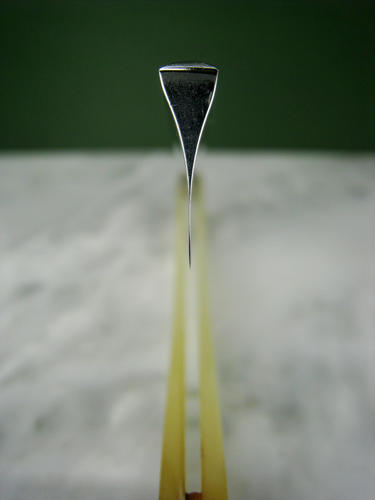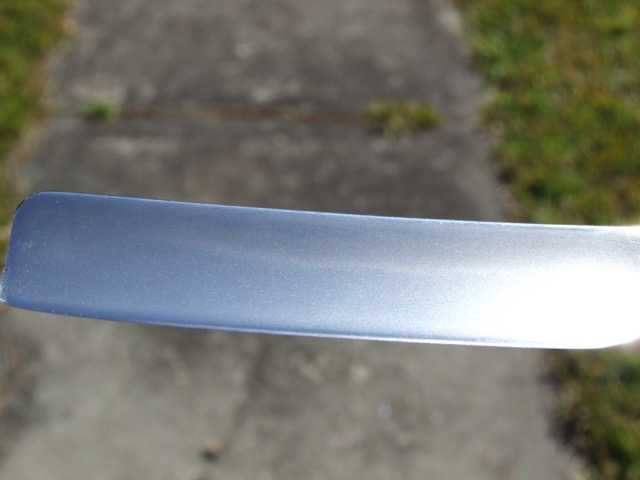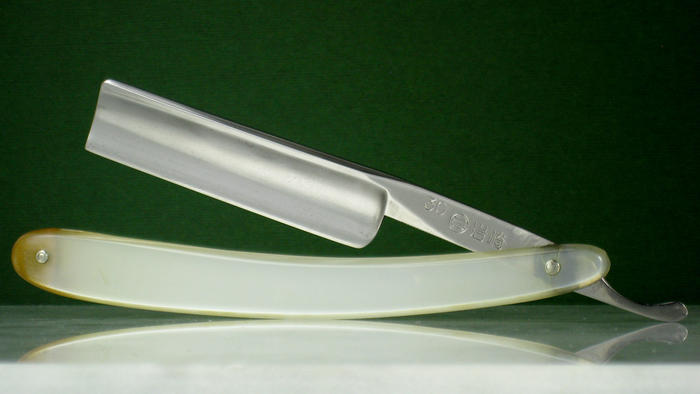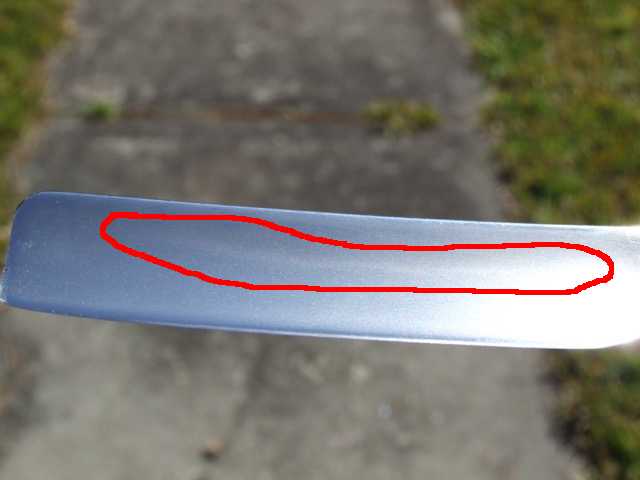Results 1 to 10 of 1173
Thread: Japanese Straights
Hybrid View
-
07-26-2017, 08:57 PM #1I used Nakayamas for my house



- Join Date
- Aug 2009
- Location
- Des Moines
- Posts
- 8,664
- Blog Entries
- 1
Thanked: 2591
-
07-28-2017, 05:02 PM #2
-
07-28-2017, 10:25 PM #3Sharp Minded Citizen

- Join Date
- Oct 2013
- Location
- Bucharest
- Posts
- 434
Thanked: 156
I had an Iwasaki no 90 identical to the one you won!...a bit more use on it then this one but otherwise identical.
It was an exceptional shaver.
Blade @0,5 -1cm shorter (I cant recall exactly but I think 2,5 inch-ish) then a regular size iwasaki....a no.50 for example is regular size @3inch cutting edge.
If I remember corectly the no 30, 60 and 90 are made a bit shorter to make them easier to sharpen by lady barbers....some are even found with the marking''Lady'' on the tang or the kanji meaning the same thing.
They are quenched horizontaly like a katana and you have to keep in mind that only 2/3 of the blade is actualy hardened....the 2/3 at the cutting edge...the spine is left soft-ish and I recomend if you always use a layer of tape when honing it.
If you ever decide to etch it...and I doubt you will...it will show a nice diferential heat treatment line.
I would box it and use it on special ocasions ... blades like this rarely pop up...and over the years they will be even rarer.
... blades like this rarely pop up...and over the years they will be even rarer.
Enjoy it!
-
07-28-2017, 10:35 PM #4I used Nakayamas for my house



- Join Date
- Aug 2009
- Location
- Des Moines
- Posts
- 8,664
- Blog Entries
- 1
Thanked: 2591
-
07-28-2017, 10:42 PM #5

I only have one Iwasaki, and it's a wonderful shaver. I wish I could afford a tamahagane in reasonable condition. If I was only allowed one razor to shave with, that would be the one.
Richard
-
07-28-2017, 10:46 PM #6

My 30 V has a 3" blade and was hardened to 64-65 HRC, which if I remember correctly is just shy of the Tamahagane hardness level of 66-67. The harder the steel, the sharper the edge because hardened steel can be ground finer than softer steel. I think Swedish steel used in razors is hardened to something likeŽ61-63 HRC. All these steels are hard enough to get and keep the finest edge possible. And that is why these makes, in particular, are so highly prized.
For an edge freak like me this is as sexy as it gets (IMHO)
 Dan
Dan
-
07-29-2017, 09:41 AM #7Sharp Minded Citizen

- Join Date
- Oct 2013
- Location
- Bucharest
- Posts
- 434
Thanked: 156
It has less to do with the steel type and mre to do with the timeframe of production....
From my research, older Iwasaki razors are quenched verticaly.
At the begining of Sanjo Works Iwasaki Kakusen colaborated with Yukio Kamijo - one of Japan's top razor makers at that time 92 years old.
Kamijo's influences are present in Iwasaki's earlier razors.
Blades are quenched verticaly...the diferential heat treatment line can be seen where the blade meets the tang=>The spine is hardened.=> razor keeps a better geometry without tape.
Steel is quenched softer then later models and is easier to sharpen and takes a sublime edge.
Tangs are stamped with both masters names...on show face for tmahagane and on the back fro sweedish steel razors.
Blade faces are mostly satin finished as oposed to mirror polished in Tanifuji colaboration.
Sometimes tangs are left rougher finished.
Kamijo loved wedge grinds so in early iwasaky - kamijo colaborations there are quite a few wedge iwasaki razors made as oposed to Tanifuji colaboration when the wedge razor became excedingly rare.
After Kamijo retired Iwasaki turned to Tanifuji Fukutaro for help and started a colaboration with him.
Iwasaki tried to modifythe tamahagane recipe....he wanted a harder steel... more ware resistant.
One of his experimental steels ment to replace tamahagane turned out a fiasco...a tad to brittle and hard to sharpen but with propper care it takes a nice edge.
This steel was dropped.
Only a few kamisoris were made in this steel.
He was obsesed with perfecting the tamahagane and making a better razor (also influences from swordmaking)so...
He ended up having a harder steel by modifying the heat treatment procedure at the old tamahagane...pushing hardness up some all the way up to 920 vickers @ 67 HRC...these blades harder then 64 HRC are a real pain in the ... to sharpen and are unforgiving.
He also changed the way the blades were quenched...from Kamijo's vertical quench...to horizontal quench...similar to katana sword quenching....These blades show a heat treat line/hamon somwhere in the upper 1/3 part of the blade towards the spine.
The spine is left softer then the cutting edge...this is why you can often see wide bevels and wide spineware on later Iwasaki razors that have been intensly used...because the spine eats up faser then the edge and decreases honing angle.
Also by this time many women began working as barbers and had difficulties honing hard razors.
This is the period when the shorter "Lady" razors started beeing produced...blade lenght shorter about 1/2 inch then standard and softer quench @ 62-63 HRC for ease of sharpen....the No.30, No.60 and No.90, No.96 are great examples of "Lady" razors. and have a cutting edge of @ 60 mm as opesed to 70mm for the regular razors.
So a few trademarks of the Tanifuji colaboration period would be:
Horizontal quench...and subsequen quench line / hamon
Harder temper ... both for sweedish steel and tamahagane.
Better finish...blades made in this period were finished at Tanifuji's facilities and have a nice near mirror finish to them.
Die - stamps...razors were no longer stamped by hand (During Kamijo colaborations some - especialy early razors were stamped by hand)
...and the lady razors.
Less wedge razors in production.
my 2 cents...hope it helps.Last edited by ovidiucotiga; 07-29-2017 at 09:45 AM.
-
The Following 5 Users Say Thank You to ovidiucotiga For This Useful Post:
doc47 (07-29-2017), Fikira (07-29-2017), JoeSomebody (08-04-2017), MikeB52 (08-04-2017), Thug (07-30-2017)
-
07-29-2017, 04:06 PM #8

Well at least some of the Iwasaki western straights made with Swedish steel have been heat treated with the Honyaki method.
I personally have not found a hamon on the examples I have in my collection, but to be honest, most of them are still waiting for their restoration, so no hamon could be visible at the moment. But here is a picture So Yamachita sent me some years ago, where the hamon is clearly visible.

Anyhow - heat treatment was something Iwasaki experimented a lot. He sent razors to barbers and asked them about the performance. If the barbers gave a feed back that the razors was to soft iwasaki hardenend them again to higher HV grades (as far as possible). Nearly all of the characters and a lot of the numbers you found on Iwasaki razor have something to do with different heat treatment.
After a couple of years that he practiced this field experiment, he recognized that the reason why a lot of barbers sent his razors back to him and claimed, was not mainly a wrong hardening, but the incompetence of the barbers in honing. That was when he wrote his essay on Honing razors and Nihon Kamisories. He also began to sell special quality whetstones at this time. I have read somewhere here in the forum that Iwasaki himself never sold whetstones. That is not true.
I have a friend who is blacksmith in Sanjo city and knows Shigeyoshi Iwasaki and Mizuichi san very well. He also bought a lot of whetstones from the last wholesaler of Iwasaki who ended his business early this year.
Sanjyo Seisakujo, the company of Iwasaki, sold Japanese whetstones, especially Maruka stamped hones for quite a while. But they stopped selling hones some years ago.
-
The Following 2 Users Say Thank You to hatzicho For This Useful Post:
Fikira (07-29-2017), markbignosekelly (08-04-2017)
-
07-29-2017, 05:30 PM #9

"So Yamachita sent me some years ago, where the hamon is clearly visible."
Can you help me to see the hamon in your photo, I'm not sure what I'm looking at. Is there a hamon in this photo?
 Dan
Dan
-
07-29-2017, 05:40 PM #10
-
The Following User Says Thank You to hatzicho For This Useful Post:
doc47 (07-29-2017)


 3391Likes
3391Likes LinkBack URL
LinkBack URL About LinkBacks
About LinkBacks







 Reply With Quote
Reply With Quote



